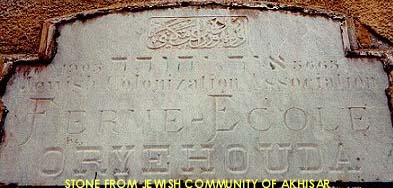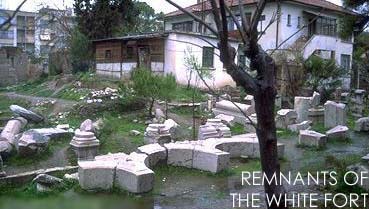The Sephardic Community of Akhisar (Thyatira), Turkey
(Kahal Kadosh Akhisar)
Introduction
Akhisar is a county located in Aegean (Western Anatolia) region in Turkey. It is the largest county in its region and a city center bigger than 32 out of 80 province capitals in Turkey. Administratively, Akhisar is located in Manisa provincial region. The district is located on a fruitful plain, surrounded by mountains that are perpendicular to the sea in East-West direction. With a population of 100,000, Akhisar is bounded to Manisa which is on Western Anatolia. In the Ottoman times, Akhisar was an important district of Saruhanli province. According to the records about 10th century, Chiosian, Venician and especially Jewish merchants were known to do business with the Istanbul market and trade cotton and woven fabrics in the area.

Figure 1. Map of western Turkey demonstrating Akhisar
Ancient History
Akhisar (or as it was known then Thyatira) was an insignificant town until it was refounded by Seleucus Nicator in the beginning of the 3rd century BCE. It was originally a military fort but lost this purpose with the rise of the Romans and soon became a wealthy commercial city. The city had a number of trade guilds. Every skilled worker was a member of a union (listed as tailors, woolworkers, tanners, potters, bakers, etc). Following the Ottoman conquest of the area known as Thyatira, the name was changed to that of Ak-Hissar [Akhisar] which means "the white fortress," [see Figure 2.] which it still bears. The white fortress that the occupying Turks found was the ruins of ancient Thyatira. They were rediscovered in 1995 CE when some construction was being attempted. Most of the ancient site remains under the streets and buildings of Akhisar. Thyatira was strategically situated on a main road that ran between Laodicea and Pergamum. The city was part of the imperial post road which linked Italy, Greece and Asia Minor with Egypt. Akhisar is 117 km (78 miles) from Izmir and 6 km (4 miles) from Or Yehouda [light of Juda], Agriculture school. In 1834 CE only three families lived there who originated from Manisa, but by 1904 CE there were 75 Jewish families.

Figure 2. Ruins of the ancient Ak-Hissar (White Fortress) of which the city gets its name.
|
Figure 3. Sign directing people into the town of Akhisar. Notice the older previous name in parentheses. |
Cemetery and Synagogue
In 1864 CE, Rabbi Moise Franco, merchant and shohet (ritual slaughterer), brought a Sefer Torah. This was the first step in the foundation of the community. In 1875 CE, on the initiative of Rabbi Moise Franco, a plot was acquired and transformed into a Jewish cemetery. After the blood libel of 1890 in Kirgagatsh, eight families who had fled, settled in Akhisar. In 1937 CE, the Jewish population was composed of ten families. There was a Synagogue, but there wasn't a Hazan, nor Rabbi, nor shohet.
The following surnames could be read on the tombstones: Asher, Bendjuya, Benuziyo, Costi, Chikiar, Cuenca, Falcon, Farhi, Franco, Gabbai, Ganon, Gaon, Mayo, Merdjan, Ninio, Pinhas, Politi.
Figure 4. Grave stone from the Jewish cemetery of Akhisar.
The cemetery is located on the south side of the city, next to the industrial center and Community Education Center. It is separated from the ancient Resatbey Muslim Cemetery, which is no longer being used, by a main road. Today there are still 32 tombstones which have survived destruction, but this number is getting smaller day by day. For years these graves were opened either manually or with bulldozers, to find money and other valuables. The marble tombstones were taken by the people in the neighborhood to be used as s in building their homes. These historical ruins are still waiting to be protected.
In 1903 CE the Synagogue was completely destroyed, but later rebuilt. In 1915 CE on the initiative of Rabbi Moise Franco, the community rented a building which was transformed into a Synagogue. This same building is still standing, and is very close to the busy street known as "Tahir On". It is located at the end of the 31st Street which is connected to Tahir On Street. Even though the Synagogue has been standing for many decades, in recent years the roof has collapsed because of the lack of maintenance, and occasionaly the grounds are looted by people coming to look for souvenirs and mementos of the old congregation.
Today, there are only the walls and doors left of the old Synagogue. The iron exterior door is locked. According to the deed record, this building belongs to the brother-in-law of a real estate Judge who works in Akhisar.
Educational Institution
Like in other small communities, Akhisar had a Talmud Torah. On the initiative of Or Yehouda Agricultural school teachers', a small general school was founded in 1903 CE. But by 1937 CE Jewish children were learning in Turkish schools. Surnames found in Akhisar schools are: Albagli, Bendjuya, Bonfil, Calvo, Cohen, Cuenca, Djelardin, Falcon, Farhi, Franco, Ganon, Garguir, Gomel, Hazan, Mayo, Mazliah, Merdjan, Navaro, Neshahon, Ninio, Pinhas, Politi, Samuel.
This original school building is situated in Kayahoglu, a town that is 10km (6 miles) away. It is a three story wood building. It was purchased in 1905 CE from the French who constructed the railroad between Izmir and Akhisar and it has always been used as an educational center until it was closed in 1996 CE for unknown reasons. After constructing a new two story concrete structure, the students moved to the new building. This school is one of the most famous of all the Alliance schools, whose numbers are decreasing at present.
Mr. Rafael Farhi, the former Jewish Community President of Akhisar, recently visited the school. You enter into the building through a huge iron gate. Located in the front is plaque that states: "Jewish Agricultural School" in the old Ottoman script (Osmanlica), "Jewish 5665 (1905 CE)", "Jewish Colonization Association" in English, "Ferme Ecole" in French and "Or Yehouda" in Hebrew were read on the door.

Figure 4. 1905 CE Stone placard from the wall of the Jewish Agricultural school [Or -Yehouda]. Placed by the the Jewish Colonization Association.
The school is the property of Manisa Private Real Estate Directorate and spread over approximately 10 acres. Efforts were made to use the original building again as an education establishment, but were never approved. Possibly because it is unsafe. It is not uncommon for people in Akhisar to discuss the future demise of the school, saying it will be burned completely, and the timbers used as fuel.
According to Akin Tütüncü and Mehmet Ün of Akhisar, the School of Agriculture built by the Jewish community in Kayalioglu town is still in good shape, but not used. The building was built in the beginning of 20th century. This large building can be noticed from Turkish State highway 565 connecting Akhisar to Izmir. There are grape orchards and various trees surrounding the building. The basement of the building served as a winery. For a personal account of what life was like in the Akhisar Or Yehouda school, please consider Souvenirs d'Alliance d'Alfred Goldberg.
The Jewish Settlement in Akhisar
Akhisar became a leader in woven goods because of its high quality cotton crop. In the year 1640 CE, Akhisar cloth, belt and cotton yarn were the most demanded goods in the Istanbul market. Additionally, the special lining called "CUKA" was being used to develop Ottoman soldiers uniforms', and this material was exclusively being woven in Akhisar. Jews from Salonika relocated to Akhisar in order to produce and sell CUKA. As a result of the regression in the Ottoman Empire that started in the 17th century, the city's economy gradually weakened. It was at this point the farmers started planting and harvesting "Oriental Tobacco," which became the most vital crop of the economy.
The Community Today
Most Jews left the city around 1965 CE. The population which was 47,535 in 1977 CE, became 80,000 CE in 1990 CE and is above 100,000 now in the year 2000 CE. The Caglak Festival and 3rd International Folklore Festival that will be held this year are indicators of the cultural accumulation at the district.
If or your family is from this community, please let us know.
Sources & Contributions:
Alliance Israelite Universelle: http://www.aiu.org/publications/nadir/reperes.htm
Tutunco, Akin. The Jewish Settlement In Akhisar. Akhisar, Turkey.
Ün, Mehmet. Akhisar Researcher. Visit his Akhisar website at http://www.akhisar.com
Contributions by Mathilde Tagger Prepared for the web by Rhonda Murrell